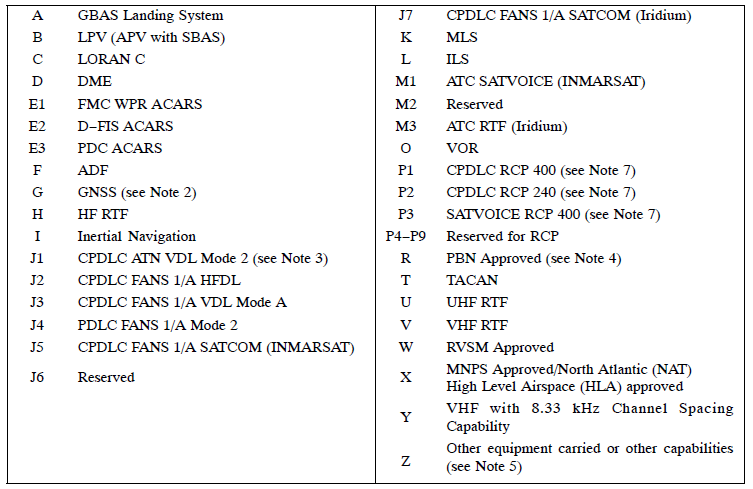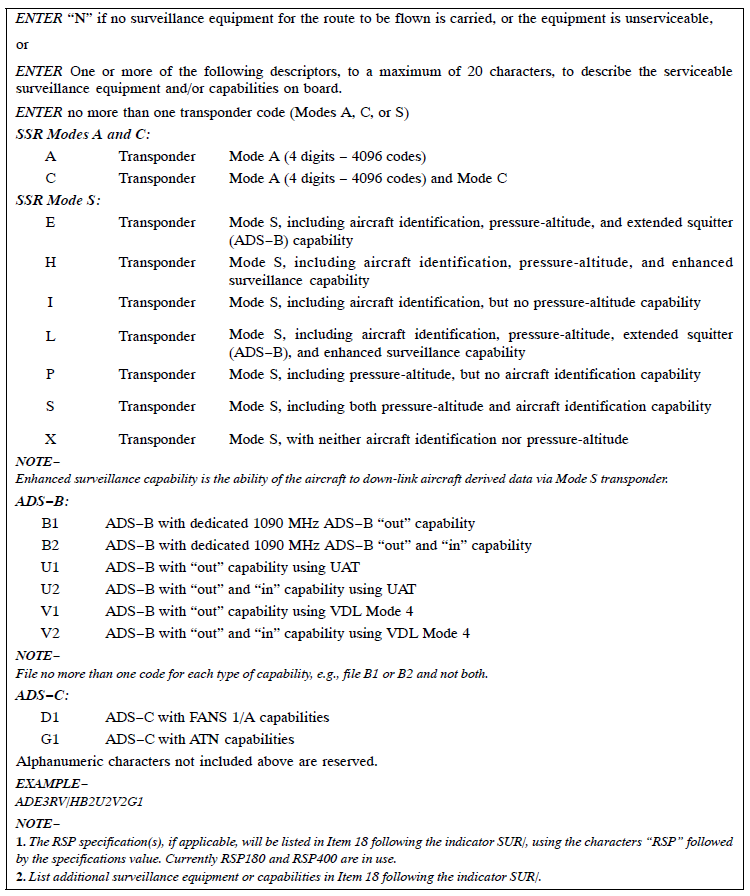Appendix A. FAA Form 7233-4, International Flight Plan
DoD Form DD-175 and FAA Form 7233-1 are considered to follow the same format.
- Any flight that will depart U.S. domestic airspace. For DoD flight plan purposes, offshore Warning Areas may use FAA Form 7233-1 or military equivalent.
- Any flight requesting routing that requires Performance Based Navigation.
- Any flight requesting services that require filing of capabilities only supported in the international flight plan format.
- Flight Plan Contents
- A flight plan will include information shown below:
- Flight Specific Information (TBL A-1)
- Aircraft Specific Information (TBL A-19)
- Flight Routing Information (TBL A-20)
- Flight Specific Supplementary Information (Item 19)
- The tables indicate where the information is located in the international flight plan format, the information required for U.S. domestic flights, and the location of equivalent information in the domestic flight plan format.
- International flights, including those that temporarily leave domestic U.S. airspace and return, require all applicable information in the international flight plan. Additional information can be found in ICAO Doc. 4444 (Procedures for Air Navigation Services, Air Traffic Management), and ICAO Doc. 7030 (Regional Supplemental Procedures) as well as the Aeronautical Information Publications (AIPs), Aeronautical Information Circulars (AICs), and NOTAM s of applicable other countries.
TBL A-1
Flight‐Specific Information
International Flight Plan (FAA Form 7233-4)
Domestic U.S.
Requirements
Equivalent Item on Domestic Flight Plan (FAA Form 7233-1)
No need to file for domestic U.S. flight
Equipment and Capabilities
Item 18 PBN/; NAV/; COM/; DAT/; SUR/
Include when date of flight is not today
Reasons for Special Handling
Item 18 STS/; RMK/
Include when special category is applicable
Include when necessary
No need to file for domestic U.S. flight
Flight Plan Originator
No need to file for domestic U.S. flight
- Instructions for Flight‐Specific Information Items
- Aircraft Identification (Item 7) Aircraft Identification is always required. Aircraft identification must not exceed seven alphanumeric characters and be either:
- The ICAO designator for the aircraft operating agency, followed by the flight identification (for example, KLM511, NGA213, JTR25). When in radiotelephony the call sign to be used by the aircraft will consist of the ICAO telephony designator for the operating agency followed by the flight identification (for example, KLM511, NIGERIA213, JESTER25);
- The nationality or common mark and registration of the aircraft (for example, EIAKO, 4XBCD, N2567GA), when:
- In radiotelephony, the call sign to be used by the aircraft will consist of this identification alone (for example, CGAJS) or preceded by the ICAO telephony designator for the aircraft operating agency (for example, BLIZZARD CGAJS); or
- The aircraft is not equipped with radio.
- Standards for nationality, common and registration marks to be used are contained in Annex 7, Chapter 2.
- Provisions for using radiotelephony call signs are contained in Annex 10, Volume II, Chapter 5. ICAO designators and telephony designators for aircraft operating agencies are contained in Doc 8585—Designators for Aircraft Operating Agencies, Aeronautical Authorities and Services.
Some countries' aircraft identifications begin with a number, which cannot be processed by U.S. ATC automation. The FAA will add a leading letter temporarily to gain automation acceptance for aircraft identifications that begin with a numeral. For flight‐processing systems (e.g., ERAM or STARS) which will not accept a call sign that begins with a number, if the call sign is 6 characters or less, add a Q at the beginning of the call sign. If the call sign is 7 characters, delete the first character and replace it with a Q. Put the original call sign in the remarks section of the flight plan.
9HRA becomes Q9HRA
5744233 becomes Q744233
- Flight Rules (Item 8a)
- Flight rules are always required.
- Flight rules must indicate IFR (I) or VFR (V).
- For composite flight plans, submit separate flight plans for the IFR and VFR portions of the flight. Specify in Item 15 the point or points where change of flight rules is planned. The IFR plan will be routed to ATC, and the VFR plan will be routed to a Flight Service for Search and Rescue services.
The pilot is responsible for opening and closing the VFR flight plan. ATC does not have knowledge of a VFR flight plan's status.
- Type of Flight (Item 8b)
- The type of flight is optional for flights remaining wholly within U.S. domestic airspace.
- Indicate the type of flight as follows:
• G - General Aviation
• S - Scheduled Air Service
• N - Non‐Scheduled Air Transport Operation
• M - Military
• X - other than any of the defined categories above
- Equipment and Capabilities (Item 10, Item 18 NAV/, COM/, DAT/, SUR/)
- Equipment and capabilities that can be filed in a flight plan include:
• Navigation capabilities in Item 10a, Item 18 PBN /, and Item 18 NAV/
• Voice communication capabilities in Item 10a and Item 18 COM/
• Data communication capabilities in Item 10a and Item 18 DAT/
• Approach capabilities in Item 10a and Item 18 NAV/
• Surveillance capabilities in Item 10b and Item 18 SUR/
- Codes allowed in Item 10a are shown in TBL A-2. Codes allowed in Item 10b are shown in TBL A-3. Codes recognized in Item 18 NAV/, COM/, DAT/ and SUR/ are shown in TBL A-4. Note that other service providers may define additional allowable (and required) codes for use in Item 18 NAV/, COM/, DAT/, or SUR/. Codes to designate PBN capability are described in TBL A-5.
Radio communication, navigation and approach aid equipment and capabilities
ENTER one letter as follows:
N if no COM/NAV/approach aid equipment for the route to be flown is carried, or the equipment is
unserviceable,
OR
S if standard COM/NAV/approach aid equipment for the route to be flown is carried and serviceable (see Note 1),
AND/OR
ENTER one or more of the following letters from TBL A-2 to indicate the serviceable COM/NAV/ approach aid equipment and capabilities available.
TBL A-2
Item 10a Navigation, Communication, and Approach Aid Capabilities

Any alphanumeric characters not indicated above are reserved.
- If the letter “S” is used, standard equipment is considered to be VHF RTF, VOR, and ILS , unless another combination is prescribed by the appropriate ATS authority.
- If the letter “G” is used, the types of external GNSS augmentation, if any, are specified in Item 18 following the indicator NAV/ and separated by a space.
TBL A-3
Item 10b Surveillance Capabilities

TBL A-4
Item 18 NAV/, COM/, DAT/, and SUR/ capabilities used by FAA



